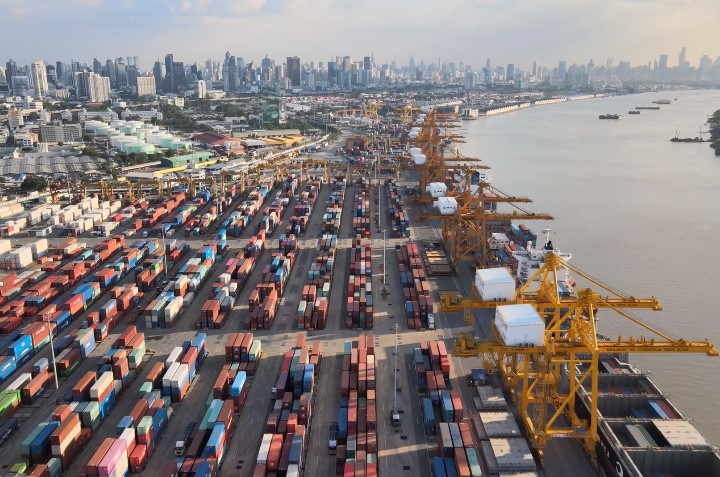Amidst the bustling symphony of business operations, the supply chain strategy often operates as the conductor, seamlessly directing multiple functions towards a harmonious outcome.
Understanding its nuances is akin to peeling an onion, with each layer revealing more depth and complexity. So, let’s peel away further.
When we talk about a supply chain strategy, we’re referring to a roadmap that delineates the orchestration of products, finances, and data from the initial source to the customer’s hands.
It is the master plan that ensures efficiency, profitability, and sustainability across all business operations.
The Anatomy of Supply Chain Strategy: An Elaborate Breakdown

Navigating through the labyrinth of modern business operations, it’s essential to comprehend the intricate framework that is the supply chain strategy. This overarching strategy acts as the backbone, ensuring that every operational facet functions in a coherent and efficient manner. Let’s dissect this anatomy to understand its components, significance, and working.
1. The Lifeblood: Products, Finances, and Data
- Products: At the heart of every supply chain is the product – be it tangible goods, services, or digital commodities. The trajectory of a product, from raw materials to the end-user, is meticulously mapped in the supply chain strategy. This includes sourcing, production, storage, and finally, delivery.
- Finances: It’s not just about the cost of production. The financial facet encapsulates procurement budgets, production costs, logistics expenditures, returns, and revenue. A well-structured supply chain strategy ensures optimal utilization of funds, maximizes profit margins, and safeguards against potential financial pitfalls.
- Data: In the age of digital transformation, data stands as a pillar of supply chain strategy. From predictive analytics determining demand surges to real-time tracking of shipments, data drives decision-making, fosters transparency, and bolsters operational agility.
2. The Guiding Blueprint: Roadmap Creation

A supply chain strategy isn’t crafted overnight. It’s a dynamic blueprint, often revisited and revised in response to market fluctuations, technological advancements, and organizational goals. This roadmap:
- Identifies Key Players: From suppliers to logistics partners, to retail outlets or digital platforms, it pinpoints every stakeholder.
- Determines Flow & Sequence: It chalks out the product’s journey, step-by-step, ensuring minimal delays and maximum efficiency.
- Incorporates Contingencies: In a world of uncertainties, from geopolitical unrest to sudden market disruptions, the strategy is embedded with alternative routes and backup plans.
3. The Ultimate Goals: Efficiency, Profitability, and Sustainability
- Efficiency: It’s about doing more with less. An adept supply chain strategy reduces redundancies, optimizes resource utilization, and accelerates processes. The result? Faster deliveries, satisfied customers, and a lean operational model.
- Profitability: Beyond mere revenue generation, the strategy aims for healthy profit margins. By negotiating better deals with suppliers, optimizing storage costs, reducing wastages, and ensuring timely deliveries, it directly impacts the bottom line.
- Sustainability: In an era where businesses are scrutinized for their environmental and social footprints, the supply chain strategy is also a pledge for responsibility. This means ethical sourcing, green logistics, recyclable packaging, and practices that echo a commitment to the planet and its people.
The Intricacies of Supply Chain Components

Delving deeper into the cogs that form the intricate machinery of a supply chain strategy:
Demand Planning:
While superficially, demand planning might seem all about gauging market pulses, in reality, it is a complex matrix of processes.
- AI and Predictive Analysis: The power of artificial intelligence has enabled businesses to not just analyze current demands but also to predict future shifts. By integrating AI algorithms, businesses can spot emerging trends, thus adapting their production and distribution plans dynamically.
- Feedback Loops: Sales teams are the ground soldiers, witnessing real-time market fluctuations. Establishing robust feedback loops ensures that this grassroots-level information is continuously funneled back into the strategy-making process, adding layers of accuracy to demand forecasting.
- Real-time Data Analytics: The market waits for none. Real-time analytics tools ensure that businesses can adjust their strategies on-the-fly, reacting to market changes as they happen, rather than playing catch-up.
Sourcing and Procurement:

This is not just a transactional relationship but a partnership built on trust and mutual growth.
- Annual Reviews and Feedback: Regular check-ins with suppliers ensure that both parties are aligned in terms of quality, delivery, and expectations. It’s an opportunity to discuss challenges and find solutions collaboratively.
- Joint Business Plans: When suppliers and businesses co-create plans, it signals long-term commitment. It means both parties are invested in mutual growth, navigating market challenges together.
- Co-innovation: The idea here is synergy. Instead of working in silos, suppliers and businesses come together to brainstorm, innovate, and co-create solutions that could redefine market standards.
Production:
Modern production isn’t about quantity but about quality and efficiency.
- Lean Management Principles: Originating from Toyota’s production system, lean principles focus on reducing waste in the production process, ensuring that every step adds value to the final product.
- Six Sigma Methodologies: This set of techniques aims to improve production processes, minimize defects, and ensure consistent product quality.
- Continuous Improvement: The market is ever-evolving, and so should the production processes. Regular reviews, feedback sessions, and proactive improvements ensure that the production line is always at its optimal best.
Distribution:
Today, distribution goes beyond trucks and warehouses.
- Drone Deliveries: The future is here. Drones promise faster deliveries, especially in hard-to-reach areas, revolutionizing last-mile delivery.
- Smart Warehousing: Integrating IoT devices, AI-driven inventory management, and robotics, modern warehouses are hubs of efficiency and accuracy.
- Anticipatory Shipping Models: Amazon has already patented this model, which is all about predicting what customers might order based on their behavior and then pre-shipping these products closer to them.
Returns and Repairs:
A once-dreaded aspect of business is now an opportunity.
- Circular Economy: Instead of the traditional ‘make, use, dispose’ model, businesses are now embracing ‘make, use, return, refurbish, and reuse,’ ensuring sustainability and reduced wastage.
- Refurbishing: Many companies are setting up dedicated refurbishing units where returned products are repaired and sold as ‘like new’ items at discounted prices.
- Recycling and Upcycling: Beyond repair, products are now being disassembled, with their components being reused (upcycling) or processed for raw materials (recycling).
The Far-reaching Impacts

Diving into the broader implications of these intricate components:
1. Competitive Advantage:
Redefining competition means not just doing what others do but doing it better, faster, and more innovatively. Amazon’s two-day Prime delivery set a new standard, while Apple’s meticulous supply chain ensures top-tier product quality and timely launches.
2. Cost Efficiency:
When supply chain processes from sourcing to distribution are optimized, wastages reduce, operations streamline, and costs plummet. The savings achieved can be redirected towards R&D, marketing, or even passed on to customers, creating a competitive edge.
3. Meeting Customer Expectations:
The modern customer is informed, demanding, and fickle. To win their loyalty, businesses need to offer more than just products. They need to offer experiences. A nimble, efficient, and customer-centric supply chain ensures that products reach faster, return processes are hassle-free, and the overall customer journey is delightful.
FAQs
How often should a supply chain strategy be revised?
Ideally, a supply chain strategy should be reviewed annually to ensure its alignment with current market trends and organizational goals. However, significant changes in the business environment, like major technological advancements or geopolitical shifts, may necessitate more frequent revisions.
How do digital transformations like blockchain impact the supply chain strategy?
Digital transformations, such as blockchain, introduce transparency, security, and traceability into the supply chain. They can help in authenticating product origins, ensuring contract compliance, and reducing fraudulent activities. Adapting to such technologies may require adjustments in the existing supply chain strategy to fully harness their potential.
What role does employee training play in an effective supply chain strategy?
Employee training is pivotal. A supply chain strategy is only as good as the individuals executing it. Regular training ensures that employees are updated with the latest tools, technologies, and best practices, which in turn, ensures efficient and seamless strategy implementation.
Can small businesses benefit from having a detailed supply chain strategy as much as large corporations?
Absolutely! While the scale and complexity might differ, the fundamental principles of efficiency, profitability, and sustainability apply to businesses of all sizes. For small businesses, an effective supply chain strategy can lead to cost savings, improved customer satisfaction, and competitive differentiation.
How do global events, like pandemics or geopolitical tensions, affect the supply chain strategy?
Global events can have profound impacts on supply chains. For instance, pandemics can disrupt manufacturing hubs or impede logistics due to lockdowns. Geopolitical tensions might lead to trade restrictions or tariffs. An adaptive supply chain strategy will factor in such uncertainties and have contingency plans in place to mitigate potential disruptions.
With the increasing importance of e-commerce, how is the supply chain strategy adjusted to cater to online consumers?
E-commerce has revolutionized consumer expectations regarding delivery times, return policies, and customization. Consequently, supply chain strategies need to adapt by focusing on efficient last-mile deliveries, flexible return and repair systems, and perhaps even localized warehousing to ensure quick turnarounds. Integrating advanced data analytics can also help in forecasting demand from online channels more accurately.
Conclusion
The supply chain strategy is the unseen force that underpins a business’s success in the modern era. Its complexities, challenges, and opportunities define the trajectory of businesses, making it an area that demands attention, respect, and continuous investment. In the grand tapestry of business operations, an effective supply chain strategy is the thread that holds everything together.
